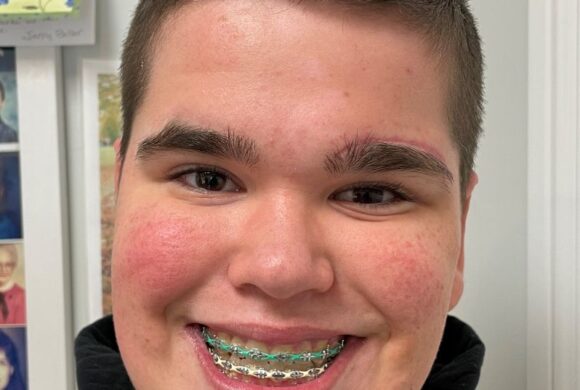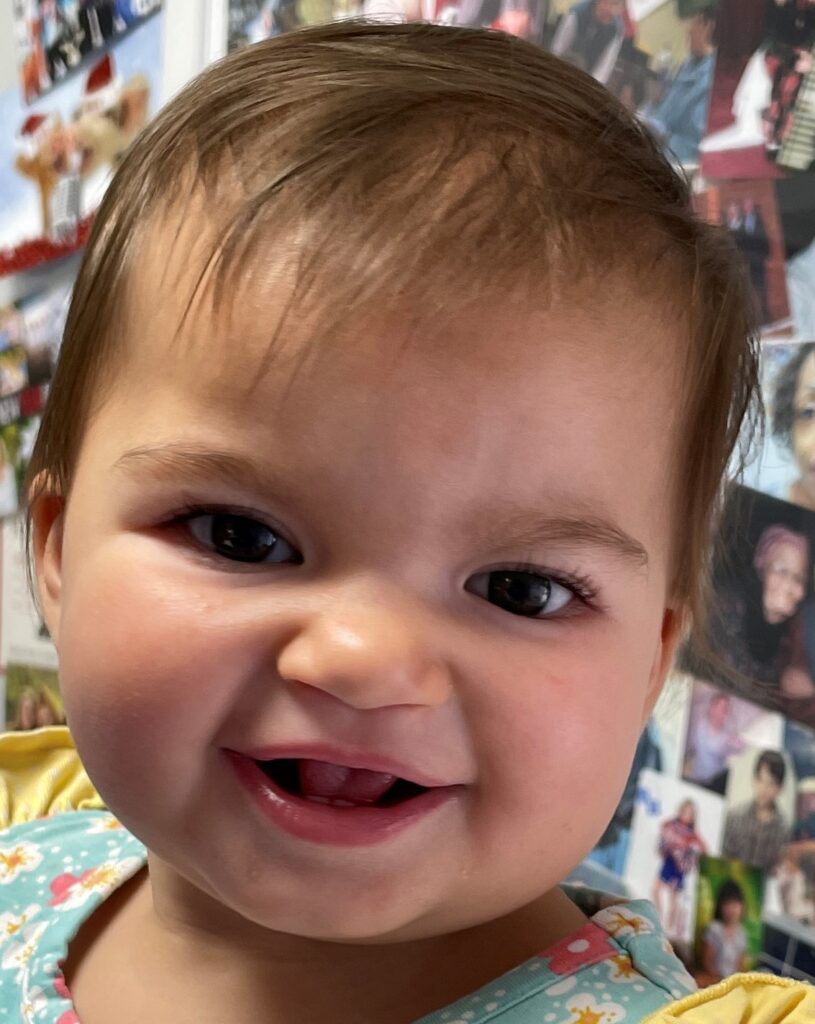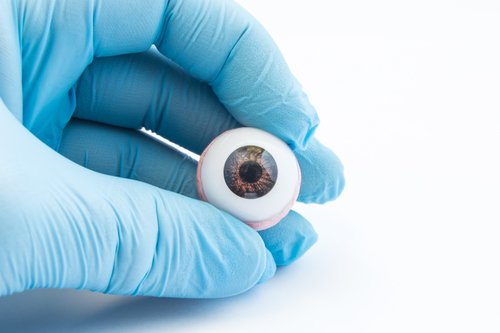Enucleation vs Evisceration
The Custom Made Prosthetic Eye Following Your Surgical Procedure
The surgery to remove the entire live eye is called an enucleation. The enucleation involves the detachment of the six eye muscles and the optic nerve. The procedure includes the removal of the eyeball and its internal contents. Once the eye is removed, the muscles are reattached around the ocular implant. The implant is intended to replace the volume of the lost globe. The surgery to remove the contents of the live eye is called an evisceration. The evisceration involves the surgical opening of the eye around the iris. This procedure requires the removal of all internal contents. An orbital implant is then placed inside the eyeball casing to replace the lost volume.
Patient Education:
Enucleation or evisceration surgical procedures will require that the patient be fit with an ocular prosthetic eye. This process begins at four weeks post-surgery. At four weeks the patient should be fit with a custom clear conformer. A custom conformer is designed at four weeks to begin development of the socket contours in preparation for the actual ocular prosthesis. The process for the fitting and fabrication of the custom prosthesis will require two more appointments. The first of the two appointments, at six to eight weeks post-surgery will be the initial fitting of the prosthesis. Our professional staff, the ocularist will take an impression or another advanced fitting method to accurately reflect the exact anatomical contours of the socket, for security, symmetry, and motility. The ocularist will be hand sculpting the prosthesis by focusing on your lid contours to match the symmetry of the companion eye. The pupil position and angulation will be denoted as well.

The second appointment will be at approximately eight weeks post op. We will focus on the artistic interpretation of your companion eye which will be translated into your new prosthetic design. The skill and precision of our ocularist allow for a natural reflection of sameness. We find that patients are thrilled as their new eye comes to life. French silk threads are utilized to create the blood vessels to simulate that of the companion eye. Please visit our photo gallery.
Replacing your custom-made prosthetic eye will be necessary at about five years. The time period varies per individual dependent upon their natural tearing, allergies, work environment, and lid function. Being seen on a regular six month basis provides for the very best upkeep of your ocular prosthesis and most current evaluation of your cosmesis, security, and hygiene. Replacement of your custom ocular prosthesis mean that we will create an entirely new eye respectful of any changes that may have taken place in your socket or lid tissues. A newly refit custom prosthesis will allow for maximum comfort and hygiene and improved movement. Please contact our office and indicate that you wish to schedule an appropriate appointment for replacement.
Microphthalmia vs Anophtholmia:
What is Anophthalmia? Congenital anophthalmia is a birth defect of a baby’s eye or eyes. Babies who experience congenital anophthalmia are born without one or both eyes. It can occur alone or with other birth defects as part of a syndrome.
What is Microphthalmia? Congenital microphthalmia is a birth defect that causes a baby’s eye or eyes to be abnormally small. The growth of the eye or eyes may be arrested during the course of intrauterine development. The result would be eyes that do not develop to their full potential. The size can vary from microscopic to 94% of the size of a full globe.
Hetzler Ocular Prosthetics Inc. is dedicated to helping create happy lives for our pediatric patients. Comforting and educating parents is an initial step, our hope is to eliminate anxiety for mommy’s, daddy’s and siblings. We will help you to better understand the medical condition of your child. We will share with you the methods that we will use to achieve our goals. We want this to be a fun and rewarding experience for our little patients and their families. We do not require anesthesia for our patients. We will utilize a step-by-step method to accomplish a rewarding and natural result. Obviously, this will take time. After we have met with your child, we will lay out a treatment plan and estimation of the goals we plan to achieve. Hetzler Ocular Prosthetics Inc. has enjoyed working in pediatrics for over 43 years. There is an art and a true joy in working with children. We thank you for considering Hetzler’s to be your team leader for your child’s prosthetic eye care.
Pediatric prosthetic and expansion therapy:
We specialize in expansion therapy in pediatric sockets that have not fully developed. Some sockets might be extraordinarily small requiring and extended time period for development. Our experienced team will focus on the development of the small socket with consecutively larger expansion conformers designed specifically for your child. Great care is taken in the designing of these pieces and educating the family about how they are utilized. Our goal Is to create tissue development and orbital and facial growth. We find that open communication helps to eliminate fears and ensure a productive process for everyone involved.

Custom made prosthetic eye:
Fitting the prosthetic eye begins with a board certified ocularist taking an impression mold or other advanced fitting methods to accurately contour or manipulate the anophthalmic socket. These techniques are utilized to ensure the prosthesis has optimal cosmesis, comfort, and movement.
Our team of board certified ocularists have developed advanced art and sculpting techniques to recreate prosthetic eyes with the most lifelike and natural appearance. These techniques focus on carefully matching eyelid contours, eyelid folds, and other features involved in achieving facial symmetry. Every effort will be made to maximize the amount of movement and to recreate an exact color match to your natural eye.

Custom scleral shell:
A scleral cover shell prosthesis is designed to be worn over your live blind/Phthisical globe. This shell prosthesis is designed to cover the entire surface of your globe. The scleral shell prosthesis is typically extremely thin. The wearing of a scleral cover shell prosthesis has multiple medical applications. Wearing a shell over a damaged globe can help retain moisture over a dry opaque cornea. The wearing of a shell also allows for a smooth contour for a natural blink function. This is important for a natural tear flow for the eyelid drainage system. Emotionally, patients benefit greatly by the restoration of a natural appearance. This should not be considered cosmetic even though the aesthetic value can be greatly improved. The ocularists goal is to accomplish a flush secure fit over the live globe. An impression or advanced technique is used to determine the custom design.
The initial step is to create a clear acrylic trial lens. Once the patient can wear the trial lens successfully, we can move into the next stage which is the scleral cover shell prosthesis. The custom artwork of the iris nicely camouflages the blemished or disfigured live eye. Motility of a scleral cover shell prosthesis is often excellent. The cover shell prosthesis will successfully restore the life like appearance the patient desires.
Handling and care:
Hetzler Ocular Prosthetics Inc. is more than a prosthetics fabrication lab in Fishers, IN—we help you with every aspect of ocular prosthetic care. It is our goal to help our clients, from babies to adults, live comfortably with their prosthetic eye.
Tips for Ocular Prosthetic Handling
We are here to guide you on every aspect of ocular prosthetic handling. The greater care you take in handling your ocular prosthesis, the longer it will last.
- Your ocularist will take time to teach you how to insert and remove your prosthesis, this is a simple procedure. You will adapt with ease.
- Always wash your hands thoroughly before handling the prosthesis
- If you are removing or cleaning the prosthesis, lay a soft towel down as a layer of protection in case you drop it.
- Remove the prosthesis only as necessary for cleaning or as often as directed. You can remove a prosthetic eye either with your fingers or with a suction cup.
- Insert the prosthesis either with your fingers or with a suction cup, making sure the prosthesis is set into position.
- Press back to secure suction
Care for your ocular prosthesis is extremely important and very easy. At home care, to ensure your prosthesis stays clean and comfortable note the following guidelines.
- Remove the prosthesis only as necessary for cleaning or as often as directed. You can remove a prosthetic eye either with your fingers or with a suction cup.
- Insert the prosthesis either with your fingers or with a suction cup, making sure the prosthesis is set into position.
- Press back to secure suction
- Remove the prosthesis only as necessary for cleaning or as often as directed. You can remove a prosthetic eye either with your fingers or with a suction cup.
- Insert the prosthesis either with your fingers or with a suction cup, making sure the prosthesis is set into position.
- Press back to secure suction
In office care, to ensure the excellent condition of your prosthesis note the following guidelines
- You should visit your ocularist every six months. The prosthesis can be carefully examined for fit, condition, and hygiene.
- Should the surface of the prosthesis be scratched or nicked be seen in the office promptly.
- Should you be struggling with excess discharge or accumulated crusting contact the office to discuss your current hygiene program.
- Removal of accumulated protein is critical to the health of your socket and the back of the eyelids.
- In office the prosthesis will be sterilized, resurfaced and polished in the lab.
- This should never be done by anyone other than you ocularist, not a dentist, optometrist, nor ophthalmologist.
Consult with an Ocular Prosthetic Specialist
Hetzler Ocular Prosthetics Inc. understands that a diagnosis of retinoblastoma is difficult for patients of any age. We provide comfort, encouragement and a beautiful new eye to restore appearance. Call us today at 317-598-6298 to learn more.

